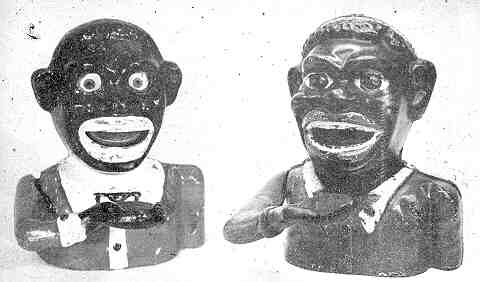English Bust Banks — Part I
by F.H. Griffith - HOBBIES Magazine - May, 1971

Over a number of years the writer has mentioned at appropriate times the fact that the English excelled in their production of the bust type mechanical bank. That is to say, by intent or not, the English made many more kinds and types of the bust mechanicals than were made in the United States or anywhere else for that matter. There has never seemed to be any particular reason or explanation as to why such a variety of bust banks were made in England — that is beyond the point that they must have enjoyed a certain amount of popularity and certainly the manufacturers would not have made so many different types had they not sold to the public at least to a varying degree.
Well there is a possible logical explanation and this has to do with the size of the English coins, particularly the penny. (This is prior, of course, to the recent change in English coinage.) Bust banks were of a type that readily adapted to the use of the quite large English coins. Specifically the hand of the bank could easily be of the necessary size to hold the oversize coins and, of course, the mouth made a naturally wide coin slot to receive bigger coins. In other words, bust banks by their very nature worked well with large size coins and this is not the case with the great majority of the mechanical banks. We must keep in mind that in the era of mechanical bank production and popularity the penny as a coin meant something and was something to save. Other than registering banks which used various denomination coins, the mechanical banks produced were in the vast majority made to operate with a penny. So it is quite logical that the bust form of bank was a natural for the use of the English penny, and since most banks in the period were commonly called penny banks this is what they were mainly made for — to save pennies.
To substantiate this point let us digress for a moment to another kind of English bank or two that operate more properly with the large English penny. Take for example the Giant In Tower, a fine rare English mechanical. It obviously works best with the most action when the English penny is used. Our penny moves or tilts the figure of the Giant only slightly forward when inserted in the slot. The English penny, however, gives the figure a good tilt — considerably more action. Now to the Football Bank, another fine English action savings device. The stump in front of the kicking figure was made in such fashion that it holds the English penny perfectly and works best with this coin. In other words the stump was actually made to hold the large penny. Finally, at this time, The World’s Banker, a great tin mechanical made in Germany for the British trade, will conclude our point. This bank requires the use of the large English penny. The American penny does not come out the globe properly when the hat of John Bull is depressed. The weight and size of the large penny is a necessary part of the operation of this bank.
Well so much of that for now and let’s get back to the bust bank and classify several of the very good English types. Figure 1 shows a fine bust known as the Jolly Nigger (Aluminum) String Tie and is No. 197 in the numerical classification. We do not know the company that made this bank, but we do know it is English and well made. It operates as do most of the bust banks and the eyes roll upward. Colors are as follows: The head is black as well as the hand. Large eyes are white with red pupils and black centers. The tongue is red and lips white. He wears a red jacket with large white collar and white cuffs. His string tie and buttons are blue. There are no markings on the bank and his back is plain with no name thereon. The bank shown is in extra fine original condition throughout and was found in England.
Our choice as No. 198 is the Jolly Nigger Fixed Eyes, Figure 2. Again this bank operates as do most bust banks with the one exception — the eyes do not move. They are part of the head casting and simply cast in the face. Actually while there is less action it makes the bank more unusual and is somewhat harder to find. Again face and hand are black, eyes are white with large brown pupils and large black centers. Lips and tongue are red with white teeth. His jacket is red with white collar. He wears a blue tie and the buttons are also blue. There’s no name on the bank and no markings of any kind. Three diamond shaped holes are in the back of the bust and four diamond shaped holes are around a round center hole in the back of the head. The bank shown is in very nice condition, all original, and was found in England. It was made by Chamberlain & Hill, Ltd., for some years prior to and through the 1920’s.
